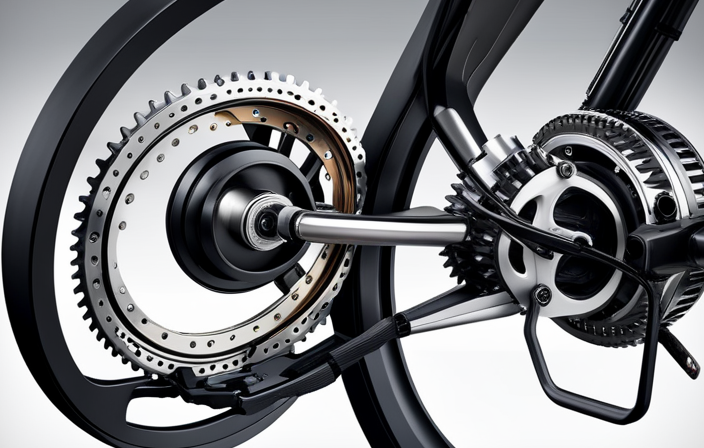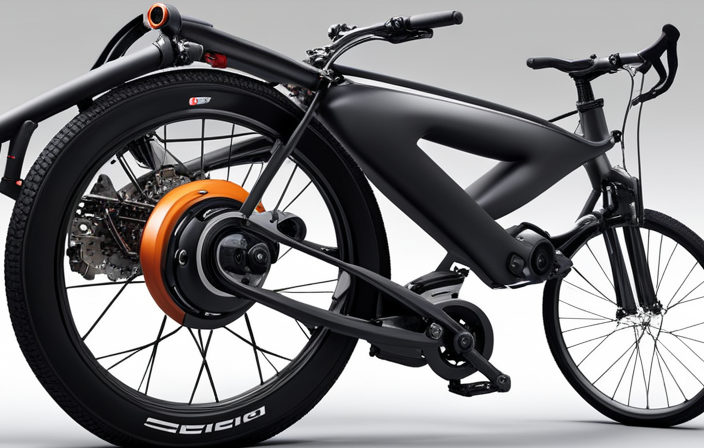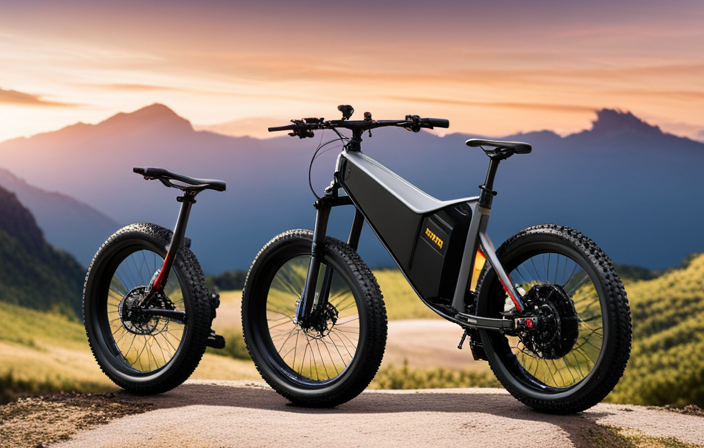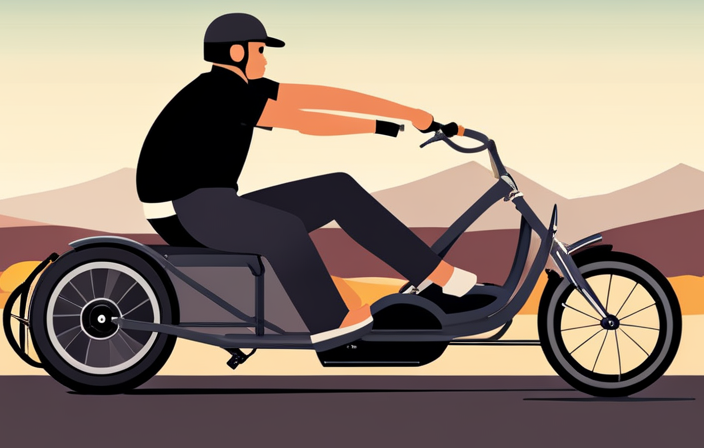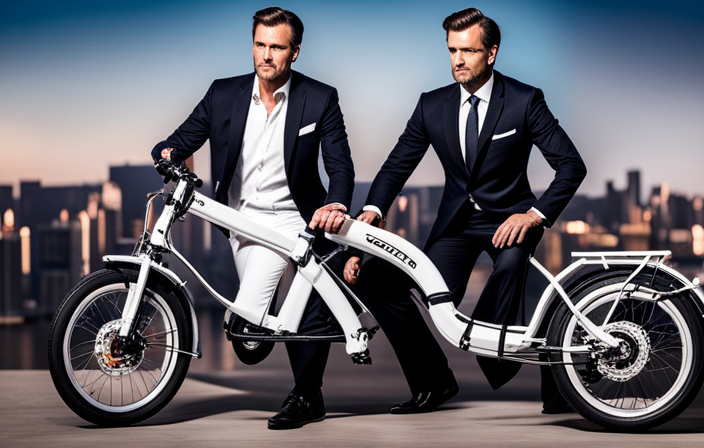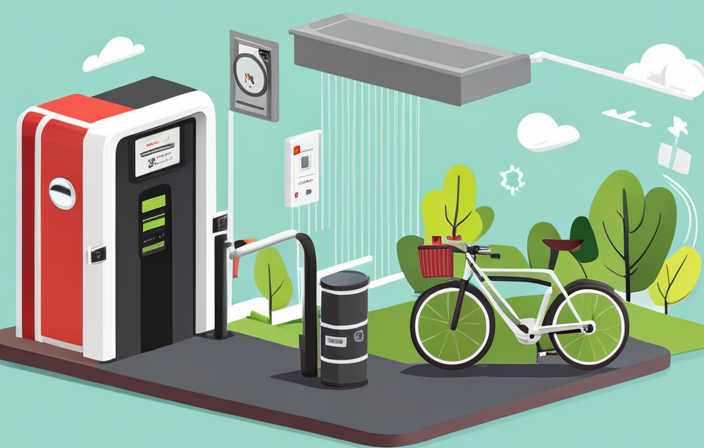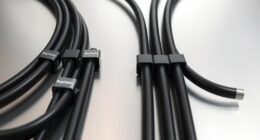As a cycling enthusiast, I’ve always been fascinated by the intricate mechanics that power our bikes. And when it comes to gear shifting, electric technology has revolutionized the way we ride.
In this article, we’ll delve into the inner workings of electric gear shifting systems, exploring their components, advantages, and even future developments.
So buckle up, because we’re about to take a thrilling ride through the world of electric gear shifting and uncover the secrets behind its seamless performance.
Key Takeaways
- Electric gear shifting technology allows for precise and effortless gear changes with the push of a button.
- The system eliminates misalignment and chain slippage, resulting in smooth and precise shifting.
- Electric gear shifting systems are lighter and require less maintenance compared to manual shifting systems.
- Popular brands such as Shimano Di2, SRAM eTap, and Campagnolo EPS offer customizable and reliable electric gear shifting technologies.
Overview of Traditional Bike Gear Shifting Systems
Traditional bike gear shifting systems use a combination of derailleurs and shifters to change gears. The derailleurs are responsible for moving the chain between different gears on the front and rear sprockets, while the shifters control the movement of the derailleurs.
This traditional gear shifting mechanism requires manual input from the rider to shift gears.
Comparing traditional gear shifting systems to electric gear shifting systems, the main difference lies in the method of gear shifting. While traditional systems rely on physical manipulation of the derailleurs and shifters, electric gear shifting systems utilize electronic components to perform the shifting action.
This allows for smoother and more precise gear changes, as well as the ability to shift gears automatically based on factors such as speed and cadence.
With this understanding of traditional gear shifting systems, let’s delve into the introduction of electric gear shifting technology.
Introduction to Electric Gear Shifting Technology
Modern bicycles have embraced the convenience of electric gear shifting technology. This innovative system offers several advantages over traditional gear shifting systems.
Firstly, electric gear shifting provides precise and effortless gear changes with just the push of a button. Unlike traditional systems that require manual adjustment, electric shifting automatically fine-tunes gear positions, ensuring optimal performance.
Additionally, electric gear shifting reduces the risk of misalignment or chain slippage, resulting in smoother and more reliable gear changes. Furthermore, this technology allows for customization and programmability, enabling riders to personalize their shifting preferences.
In comparison to traditional systems, electric gear shifting offers a seamless and efficient user experience, enhancing overall riding enjoyment. As we delve into the components of an electric gear shifting system, we will further explore the intricacies of this advanced technology.
Components of an Electric Gear Shifting System
One key component of an electric gear shifting system is the derailleur, which is responsible for changing the position of the chain on the bicycle. The derailleur is a mechanical device that moves the chain between different gears, allowing the rider to adjust the bike’s resistance and maintain an optimal pedaling cadence. It offers several advantages over traditional manual shifting systems, including smoother and faster gear changes, precise and consistent shifting, and the ability to shift gears under heavy load.
To install an electric gear shifting system, begin by removing the old manual shifting components and installing the new electronic components. Make sure to follow the manufacturer’s instructions carefully and adjust the derailleur properly for optimal performance. Regular maintenance is also crucial to ensure the smooth operation of the system. Clean the derailleur regularly, check for any loose or damaged parts, and lubricate the moving components as recommended by the manufacturer.
With the derailleur being a crucial component of an electric gear shifting system, it is important to understand how it works in conjunction with other components to provide seamless gear changes.
How Electric Gear Shifting Works
To understand the inner workings of an electric gear shifting system, you can start by examining the intricate movements of the derailleur and how it seamlessly transitions the chain between different positions. In an electric gear shifting system, a small electric motor is responsible for moving the derailleur, which in turn moves the chain to a different gear ratio. This motor receives signals from a control unit, typically located on the handlebars, that allows the rider to shift gears effortlessly with the push of a button.
To highlight the advantages of electric gear shifting, let’s compare it to mechanical gear shifting. Electric gear shifting offers precise and instantaneous shifting, eliminating the need for manual adjustments and reducing the risk of misalignment. Additionally, electric systems are generally lighter and require less maintenance compared to their mechanical counterparts.
The ease of use and smooth transitions afforded by electric gear shifting make it an excellent choice for cyclists looking for a reliable and efficient gear shifting system.
Advantages of Electric Gear Shifting
When it comes to electric gear shifting, one of the key advantages is the smooth and precise shifting it offers. With the use of advanced technology, electric shifting systems ensure seamless gear changes, eliminating any jerky movements or missed shifts.
Another advantage is the ease of use for all skill levels. Whether you’re a professional cyclist or a beginner, electric gear shifting makes it effortless to shift gears with just the push of a button, providing a user-friendly experience.
Lastly, electric shifting systems are known for their improved durability and reliability. With fewer mechanical parts and no cables to stretch or wear out, these systems require less maintenance and are less prone to malfunction, ensuring a more dependable and long-lasting performance.
Smooth and Precise Shifting
If you want smooth and precise shifting on your bike, make sure to practice proper gear shifting technique. Precision shifting is crucial for achieving optimal performance and efficiency, whether you’re on a leisurely ride or pushing your limits in a race.
Electric shifting offers numerous benefits that can enhance your shifting experience. With electric shifting, you can effortlessly and consistently shift gears with the press of a button, eliminating the need for manual adjustments. This results in quicker and more accurate shifts, reducing the risk of chain drop or misalignment.
Additionally, electric shifting systems often come with customizable shifting modes, allowing you to fine-tune your gear ratios to suit your riding style. This level of precision and control can greatly enhance your overall cycling experience.
Moving forward, let’s explore the ease of use electric shifting provides for all skill levels.
Ease of Use for All Skill Levels
Achieving smooth and precise shifting is effortless, allowing me to effortlessly navigate through the gears with ease. The electric gear shift system on this bike is designed to improve efficiency and provide a user-friendly interface for riders of all skill levels. Here are five key features that make it easy to use:
-
Intuitive controls: The gear shift buttons are strategically placed within reach, ensuring quick and accurate gear changes without taking your hands off the handlebars.
-
Seamless gear transitions: The system seamlessly transitions between gears, minimizing any disruptions in power delivery and maintaining a smooth ride.
-
Customizable settings: Riders can customize the shifting parameters to suit their preferences, optimizing performance for different terrains or riding styles.
-
Clear display: The interface provides clear and concise feedback, displaying the current gear selection and any necessary prompts for the rider.
-
Effortless maintenance: The electric gear shift system requires minimal maintenance, reducing the need for frequent adjustments or replacements.
With an emphasis on user-friendliness and improved efficiency, this electric gear shift system ensures a seamless and enjoyable riding experience.
Now, let’s explore how this technology has also contributed to improved durability and reliability.
Improved Durability and Reliability
To ensure durability and reliability, you’ll appreciate the enhanced construction and longer-lasting components of this advanced shifting system.
With its improved efficiency and impact on cycling performance, this electric gear shifting system is designed to provide a seamless and effortless riding experience.
The system utilizes cutting-edge technology to deliver precise and quick gear changes, allowing riders to maintain optimal cadence and power output.
The components are built to withstand the rigors of intense riding, ensuring longevity and minimal maintenance requirements.
The advanced design of this shifting system also minimizes the risk of mis-shifts, enhancing the overall efficiency of your cycling experience.
Now, let’s delve into the different types of electric gear shifting systems, exploring their unique features and benefits.
Different Types of Electric Gear Shifting Systems
When it comes to electric gear shifting systems for bicycles, there are several options available in the market. The Shimano Di2, SRAM eTap, and Campagnolo EPS are three of the most popular and highly regarded systems.
Each of these systems has its own unique features and advantages, making them suitable for different types of riders and preferences. In this discussion, we will delve into the technical details of these systems, analyzing their functionality, performance, and user experience.
Shimano Di2
The Shimano Di2 system uses electronic shifting to smoothly change gears on a bike. This innovative technology eliminates the need for traditional mechanical cables and instead relies on electric signals to shift gears.
The heart of the Di2 system is the electronic derailleurs, which are connected to the shifters and controlled by a central unit. When the rider presses the shift buttons on the handlebars, the signal is sent to the derailleurs, instructing them to move the chain onto the desired gears.
The Di2 system offers precise and reliable shifting, with the ability to make micro adjustments for optimal performance. It also provides customizable shift settings, such as multi-shift and synchronized shift modes, enhancing the overall riding experience.
Transitioning to the next section, let’s now explore the SRAM eTap system.
SRAM eTap
The SRAM eTap system, with its wireless technology, revolutionizes the way cyclists can change gears on their bicycles. This innovative system eliminates the need for traditional shift cables and replaces them with wireless signals, allowing for a seamless and precise shifting experience. With SRAM eTap, shifting is as simple as pressing a button.
The system uses a unique communication protocol to ensure reliable and instant gear changes, even in the most demanding conditions. The wireless shifting technology of SRAM eTap also offers a clean and clutter-free aesthetic, as there are no visible cables or wires. This system is designed to enhance the overall performance and efficiency of the bike, providing cyclists with a more enjoyable and efficient riding experience.
Transitioning to the subsequent section about Campagnolo EPS, we can explore another cutting-edge electronic shifting system.
Campagnolo EPS
To experience the latest in electronic shifting technology, you can try out Campagnolo EPS. This cutting-edge system offers precise and seamless gear changes. The Campagnolo EPS system utilizes wireless technology to communicate between the shifters and the derailleurs, eliminating the need for traditional mechanical cables.
Here’s how it works:
-
Wireless Connectivity: The shifters communicate with the derailleurs via a secure and reliable wireless connection. This ensures fast and accurate gear changes.
-
Intelligent Shifting: The EPS system features advanced algorithms that continuously monitor factors such as chainline angle, chain wear, and cassette position. This optimization enhances shifting performance.
-
Customizable Options: Campagnolo EPS allows riders to customize their shifting preferences. This includes adjusting the speed and responsiveness of gear changes.
-
Battery Life: The EPS system utilizes a rechargeable lithium-ion battery. This provides long-lasting power and minimizes the need for frequent recharging.
With its wireless technology and advanced features, Campagnolo EPS offers cyclists a high-performance and customizable shifting experience.
Now, let’s delve into the installation and maintenance of electric gear shifting systems.
Installation and Maintenance of Electric Gear Shifting Systems
Installing and maintaining electric gear shifting systems is essential for ensuring optimal performance and longevity of the bike. Proper installation techniques and troubleshooting tips are crucial to maximize the benefits of these advanced systems.
When installing an electric gear shifting system, it is important to carefully follow the manufacturer’s instructions to ensure proper alignment and functionality. Additionally, regular maintenance is necessary to keep the system in top condition. This includes checking the battery charge, inspecting cables and connections for any signs of wear or damage, and lubricating moving parts as needed.
Troubleshooting common issues, such as misalignment or sluggish shifting, can often be resolved by adjusting the limit screws or fine-tuning the system through the control unit. Ensuring proper installation and maintenance will guarantee optimal performance of the electric gear shifting system.
Moving on to cost considerations and compatibility…
Cost Considerations and Compatibility
When considering cost and compatibility, you’ll want to research different options and make sure the system is compatible with your specific bicycle model. Cost analysis is an important aspect to consider when looking into electric gear shifting systems for your bike. These systems can vary in price depending on the brand, features, and quality. It is essential to determine your budget and compare prices from different manufacturers to find the best option for your needs.
Additionally, compatibility issues may arise if the system is not designed to fit your particular bike model. It is crucial to check the specifications and consult with experts to ensure a proper fit. By conducting a thorough cost analysis and addressing compatibility issues, you can make an informed decision before purchasing an electric gear shifting system.
Moving on to user reviews and experiences, it is helpful to gather insight from those who have already used these systems to understand their effectiveness and reliability.
User Reviews and Experiences
After considering the cost and compatibility factors, it is important to delve into the user reviews and experiences of electric gear shifting technology.
As a cyclist myself, I have had the opportunity to try out an electric gear shifting system and compare it with traditional gear shifting. User satisfaction with electric gear shifting technology has been overwhelmingly positive.
The smooth and precise shifting, coupled with the ease of operation, has greatly enhanced the overall riding experience. Riders have reported that electric gear shifting provides seamless transitions between gears, eliminating any lag or misalignment commonly experienced with manual shifting.
Moreover, the ability to make quick and effortless shifts at the touch of a button has greatly improved performance and efficiency. When compared to traditional gear shifting, electric gear shifting offers unparalleled convenience and precision.
The future developments in electric gear shifting technology promise even more advancements in terms of performance, reliability, and integration with other cycling components.
Future Developments in Electric Gear Shifting Technology
The future of electric gear shifting technology looks promising, with advancements on the horizon that will further improve performance and integration with other components.
One of the key areas of development is the integration with electronic shifting systems. Currently, electric gear shifting systems rely on manual input from the rider to change gears. However, future advancements aim to automate this process by seamlessly integrating with electronic shifting systems.
This will allow for more precise and efficient gear changes, as the system will be able to accurately determine the optimal gear based on factors such as speed, cadence, and terrain.
Additionally, the integration with electronic shifting systems will enable wireless communication between the gear shifting system and other components, such as the bike’s computer or smartphone app, providing valuable data and enhancing the overall cycling experience.
Frequently Asked Questions
Can I use an electric gear shifting system on my existing traditional bike?
Yes, you can use an electric gear shifting system on your existing traditional bike. The cost will depend on the specific system you choose, and the installation process may require some modifications to your bike’s frame and drivetrain.
How does an electric gear shifting system affect the overall weight and balance of the bike?
The electric gear shifting system has a minimal effect on the overall weight and balance of the bike. However, it greatly enhances performance and improves the riding experience by providing seamless and precise gear changes at the touch of a button.
Are there any safety features in place to prevent accidental gear shifting?
The safety mechanisms in place for electric gear shifting prevent accidental gear shifting, ensuring a smooth and controlled ride. These mechanisms provide peace of mind and enhance the overall safety and reliability of the bike.
What is the average lifespan of an electric gear shifting system before it needs to be replaced?
The average lifespan of an electric gear shifting system is typically around 10,000 to 20,000 miles, depending on usage and maintenance. The benefits of an electric gear shifting system include smooth and precise shifting, improved efficiency, and reduced wear on the drivetrain components.
Can I manually override the electric gear shifting system if needed?
Yes, you can easily take control and manually override the electric gear shifting system if necessary. This provides the flexibility to adapt quickly and ensures a smoother ride. The advantages of electric gear shifting include precise and efficient gear changes for optimal performance.
Conclusion
In conclusion, after diving into the intricate workings of electric gear shifting technology, it’s evident that this innovation has revolutionized the world of cycling.
The seamless and precise shifting capabilities, combined with the convenience and ease of use, make electric gear shifting a game-changer for both professional cyclists and recreational riders alike.
The advantages, such as improved efficiency and reduced maintenance, are undeniable.
As we look towards the future, it’s exciting to anticipate the further advancements that will undoubtedly enhance the cycling experience even more.
